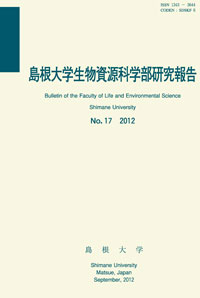島根大学生物資源科学部
ISSN:2435-0885(オンライン)
ISSN:1343-3644(冊子体)
なお、冊子体の刊行は23巻まで
ISSN:1343-3644(冊子体)
なお、冊子体の刊行は23巻まで

ダウンロード数 : ? 件
この文献の参照には次のURLをご利用ください : https://ir.lib.shimane-u.ac.jp/4794
島根大学生物資源科学部研究報告 7
2002-12-20 発行
甲殻類十脚目50種における中腸腺(肝膵臓)の系統発生および棲息様式に関連した比較形態学的研究
Comparative Histological Studies of the Midgut Glands in Crustaceans Associated with their Phylogeny
ファイル
内容記述(抄録等)
Background/aims: Crabs are characterized by more succeeded transformation during the water-to-land transition than other crustaceans. To reveal how the visceral organs were adapted them structures and functions under gravity conditions, we examined the tissue structures of midgut glands in Decapoda. The midgut gland in invertebrate species are stored large amounts of lipid and glycogen, it was predictable that early biologists would refer to these organs as "hepatopancreas" or "hepatic caeca". Methods: 53pecies crustaceans were collected from the local coasts of Shimane Peninsula, Oki Island, Amami Island and Iriomote Island. Midgut glands were fixed with paraformaldehyde, and observed by light microscopy and scanning electron microscopy. Results: The midgut gland of crustaceans was a multilocular structure of blind-ending tubuli that contained columnar alveolus cells with basal nuclei. Midgut glands were classified into three types by development in a formation pattern of the interstitial tissues in between tubules. The cytoplasms of the R cells contained substantial amounts of lipid in terrestrial groups. Conclusions: The present study indicates that there are differences of the matrix tissue structures in midgut glands that are closely related to the diverged mode of living: aquatic, aqua-terrestrial and fully terrestrial living. These findings suggest that evolutional adaptation of visceral organs has made possible only after acquirements the structural changes of matrix tissues.
About This Article
Other Article
